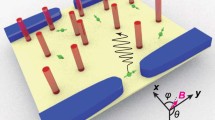Abstract
Recent experiments have demonstrated that the numbern of additional electrons on a small metallic island is a staircase function of a continuous external chargen x for temperaturesT small compared to the single electron charging energyU. We show that the finite conductanceg of the tunnel barrier connecting the island to the external gate gives rise to quantum fluctuations inn which lead to a smearing of the staircase even at zero temperature. In the experimentally relevant case of wide junctions and in the limit of small conductanceg≪1 the slope ∂<n>/∂n x at the turning point between two plateaus saturates at a finite value of order 1/g asT→0 instead of diverging likeU/T as predicted with thermal fluctuations only. The experimentally observed broadening however is still much larger which is probably due to extrinsic effects.
Similar content being viewed by others
References
Averin, D.V., Likharev, K.K.: In: Mesoscopic phenomena in solids. Altshuler, B.I., Lee, P.A., Webb, R.A. (eds.). Amsterdam: North Holland 1991
Grabert, H., Devoret, M.H. (eds.): Single charge tunneling. NATO ASI Series, Vol. 294. New York: Plenum Press 1992
Z. Phys. B85, 317 (1991) (Special Issue on Single Charge Tunneling)
Lafarge, P., et al.: Z. Phys. B85, 327 (1991)
Esteve, D.: Private communication
Matveev, K.A.: Sov. Phys.-JETP72, 892 (1991)
The electrons in the box and in the lead are thus quasiparticles within a Fermi liquid description, i.e. the Coulomb interaction there is already included
Ashoori, R.C. et al.: Phys. Rev. Lett.68, 3088 (1992); Phys. Rev. Lett.71, 613 (1993)
Duke, C.B.: In Tunneling in solids. Solid State Physics, Suppl. 10, Seitz, F., Turnbull, D., Ehrenreich, H. (eds.), Chapt. 19. New York: Academic Press 1969
Fisher, D.S., Lee, P.A.: Phys. Rev. B23, 6851 (1981); for a careful discussion of the multilead case including a finite magnetic field see Baranger, H.U., Stone, A.D.: Phys. Rev. B40, 8169 (1989)
Bardeen, J.: Phys. Rev. Lett.6, 57 (1961)
Weinmann, D.: Diplomarbeit, Universität Stuttgart 1991 (unpublished)
Leggett, A.J., et al.: Rev. Mod. Phys.59, 1 (1987)
Anderson, P.W., Yuval, G., Hamann, D.R.: Phys. Rev. B1, 4464 (1971)
Young, A.P., Bohr, T.: J. Phys. C14, 2713 (1981)
Tsvelick, A.M., Wiegmann, P.G.: Adv. Phys.32, 453 (1983); the analytic continuation is necessary because the exact solution is only possible forI ‖>I ⊥>0 while in the present case one hasI ‖=0
Flensberg, K. et al.: Z. Phys. B85, 395 (1991)
See Averin, D.V., Nazarov, Y.V.: In: [2]— for a discussion of the quasiclassical propagation of electrons in the electrodes
See the articles by Grabert, H., Devoret, M.H., or by Ingold, G.L., Nazarov, Y.V.: In: [2]—
For similar arguments in the related problem of the width of the conductance peaks in tunneling through quantum dots see van Houten, H., Beenakker, C.W.J., Staring, A.A.M.: In: [2]—
In fact Matveev also includes the actual electron spin and assumes that there is aseparate set of electron hole excitations for each spin direction, which would lead to an additional logarithmic factor\(\left\langle {\hat \sigma _z } \right\rangle \sim \varepsilon \ln 1/\varepsilon \)
Frota, H.O., Flensberg, K.: Phys. Rev. B46, 15207 (1992)
Wolf, D., Zittartz, J.: Z. Phys. B51, 65 (1983)
In principle the two species σ=±1 of Fermions lead totwo sets of oscillator modes defined fork>0 (or a single one defined forall k as used in [23]). However only one of these appears in the transfer term 341-2 for the same reason as in the Bosonization of the anisotropic Kondo problem where ‘spin’ and charge degrees of freedom separate, see [13]—
Zwerger, W., Scharpf, M.: Z. Phys. B85, 421 (1991); note that in this workH T is treated to second order but the dissipation associated with the bare conductanceg is then taken into account to all orders
It is an interesting problem to investigate to which extent the two state approximation nearn x =m+1/2 which effectively reduces theXY symmetry to an Ising one can be justified quantitively and how it breaks down with decreasingU or increasingg. In fact in the limitg≫1 one expects that\(\left\langle {\hat n} \right\rangle \approx n_x \) for arbitraryU even atT=0




